The origin of scrum tools is from the development offices of software. Even though this tool’s main purpose is for the agile development of software, there is much more to it. The framework of the scrum has multiple uses in the settings of production. For example, scrum tools have a lot of uses in construction firms, as well as in marketing agencies.
In reality, we see some of the best scrum software is also used as software for project management. This is because these scrum applications are equipped with the best functionalities for doing so. Some of these functionalities include features related to sprint planning, scrum framework following, and backlogs incorporation.
Read: Organize Your Divisions In Real-Time: Best Apps For your Business
Scrum Tools: How does it work?
When a product is produced or developed, the scrum tool mainly delivers the already set framework. The set framework can be provided for any consumer products, developing software, and making an email campaign. For the basic scrum elements, their similar framework is used for producing the scrum tools.
Many people may not know what scrum is related to. And, it is highly integrated with the product management software tools. The development of these tools are known as scrum tools, and also known as agile tools. Agile is the main relation to scrum, and this is why the tools are also known as crossover software tools.
These agile tools for project management open a great scope for developing the management software in all fields in the usual sense. This means that scrum related functions get highly developed. Also, the functions related to agile methodology get developed parallel with the rest of the software.
Generally, the scrum software has been designed for enhancing the efficiency among the members of the team. It also helps in increasing transparency, boosting collaboration, and facilitating the Scrum framework. No matter the organization, the scrum software can help them benefit in multiple factors. This is because these scrum tools help in multiple iteration planning among the members. Also, the workload is organized, and the communication gets enhanced.
Scrum Methodology and Software: What are the basic parts?
The backlog is the primary element related to any of the scrum software used for project management purposes. When compared, this is much similar to the functionality of sticky notes or whiteboards. Basically, a user can list the requirements, progress, and tasks related to the final product. Now, it is up to the user as to how they want to give priority to the items on the backlog. Every task has a unique importance and urgency, and the user needs to list them accordingly.
The owner of the product is yet another vital element of the scrum software. Consequently, these product owners have an ultimate say on which features to include and which to exclude. This is because they understand the product’s functional expectations and how to manage their business accordingly properly.
Also, sprint tools play a big factor in the development of the software. The time is predetermined and divided into different parts for completing all of the backlog tasks assigned. This is also known as sprints, and the Scrum framework facilitates the division of time. When the sprint is represented graphically, it is known as burndown charts. It is often helpful in tracking the overall process.
Scrums are conducted daily, which results in the members of the team meeting up with each other. In these meetings, they can discuss and share their progress. Also, all of the emergency issues that need to be attended to immediately are brought up. The daily scrums are easily coordinated and planned with the inbuilt features present in the scrum tools. These tools include features for scheduling meetings. As a result, after each meeting, the team members know what needs to be improved or analyzed.
Best Scrum Tools for Better Productivity
Given below are 11 of the best scrum tools that can be used to boost the team’s productivity.
1. Zoho Sprints
Zoho Sprints is the best scrum tool for real-time collaboration. This software makes the scrum framework straightforward with an easy-to-use interface. Scrum teams can organize user stories, manage backlogs, and track progress on the scrum board. The drag-and-drop functionality helps teams move work items from their project backlog to their sprint backlog. The project backlog serves as the repository of all user stories, tasks, and bugs. Refinement of the project backlog becomes easier with the availability of filter, sort, and search options.
With an easily customizable scrum board, Zoho Sprints aids visibility and transparency of team progress. The customizable statuses enable agile teams to make the scrum board compatible with their project needs. Teams can sort work items into swimlanes based on priority, story, or estimation points, and track the progress of sprints in an exclusive sprint dashboard.
Collaborative efforts are highly valued in agile methodology. To make collaboration and communication seamless, Zoho Sprints has a built-in chat function, a virtual meetings tool, and an interactive project feed.
The reports and dashboard features in Zoho Sprints help teams get insights into the overall progress of the ongoing project. The software offers burndown, burnup, and velocity charts, along with other reports that enable teams to make pivotal decisions about project progress.
With Zoho Marketplace, a growing library of integrations and apps, teams can leverage webhooks and APIs to build their own integrations. Integrations with popular tools such as GitHub, GitLab, BitBucket, Jenkins, and Azure DevOps, along with Zoho’s homegrown products, make Zoho Sprints stand out against its competitors.
Zoho Sprints offers a free 15-day trial, no credit card required. The software has three paid plans, starting at $1 per user each month, billed annually, with a commitment of 12 users. It also has a freemium version for up to three users and three projects.
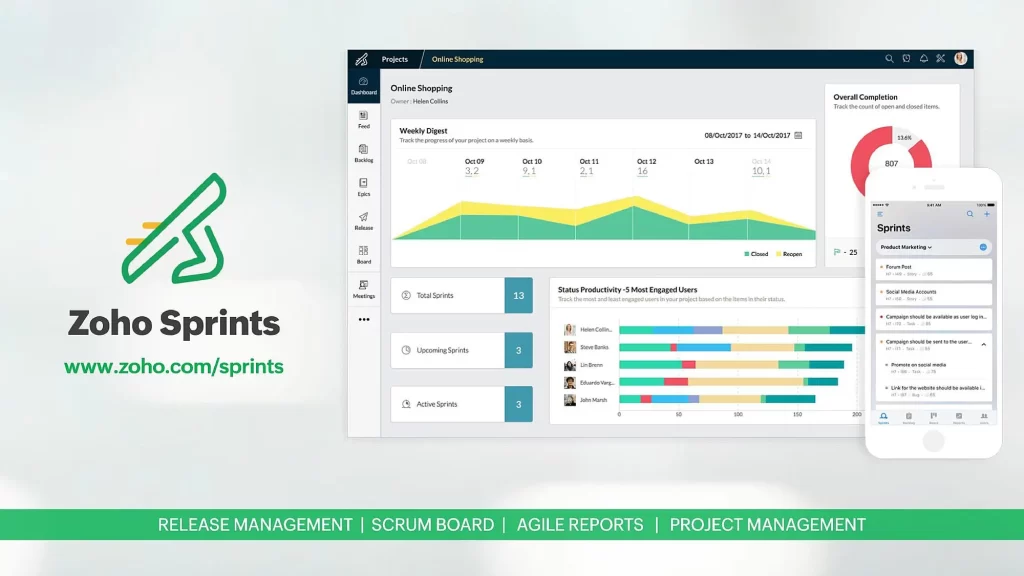
2. monday.com
This tool is one of the best for the integration and automation of the project. When it comes to the management of the project and scrum teams, monday.com is highly recommended. In this particular platform, the time tracking options are great. The notifications can be fully customized, and users can focus on important matters due to automation. Users can stay in sync and share the roadmap with others for better visualization and creativity.
The interface is very intuitive, and the availability of the sprint plans, dependencies, and backlogs increases productivity. With this tool, the creation and use of backlogs are effortless. The user has the option to choose where to sort or filter the column as per their need. Since the interface is highly customizable, the sprints can be planned in multiple different columns.
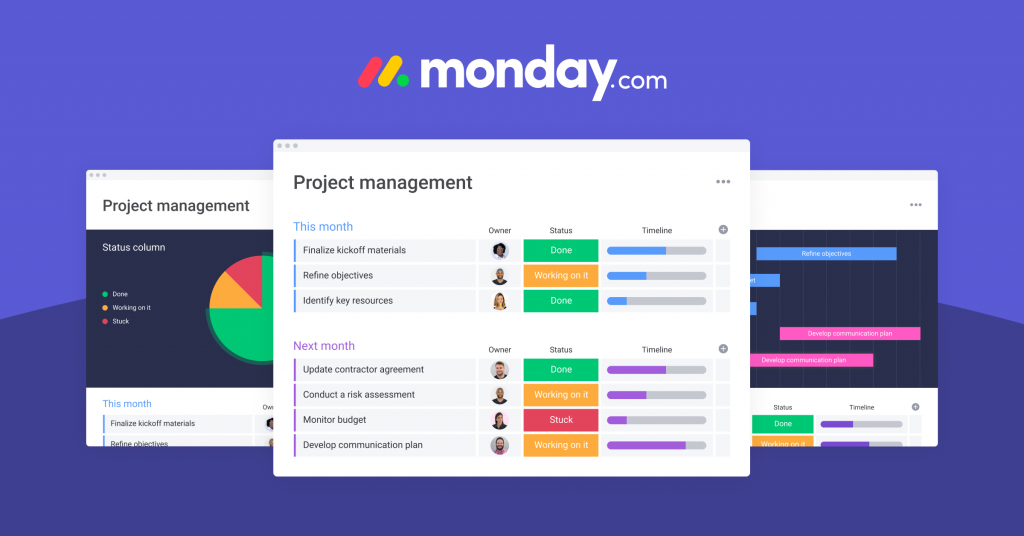
monday.com
As a result, the needs of the teams can be dealt with fitting the workflow creation. Users can also analyze their work and get multiple views on burndown chart creation. Even though the full chart isn’t available, simple charts are available for tracking the effort, capacity, and sprint progress.
Multiple apps for project management are available in the integrations of monday.com. Some of these apps include Typeform, Dropbox, Trello, GitHub, Jira, Google Calendar, Gmail, Google Drive, and Slack. These apps can be accessed with Zapier.
As for the pricing policy, monday.com charges 17 dollars per month, up to two users. A 24×7 customer support is available and can be contacted via mail or phone.
3. Wrike
Wrike is one of the best scrum tools that are available for all sized teams. This tool has won multiple awards and is very easy to use. Globally, it has demanded over 20k+ institutions, and teams of any size, be it 5 or 50, can use it. It has multiple scrum features and tools and is configurable to extreme heights. As a result, the users can easily customize their request forms, reports, dashboards and optimize their workflow.
The interface is straightforward to understand, and users can easily switch between traditional workload views, Gantt charts, and Kanban boards. There are also multiple agile templates, which comes inbuilt. Some additional features include collaboration in real-time, file sharing, workflow sharing, schedules, subtasks, and listing tasks. Users can also easily prioritize their Kanban boards, Gantt charts, sprint plans, and backlogs. The sprint success can be easily tracked as well.
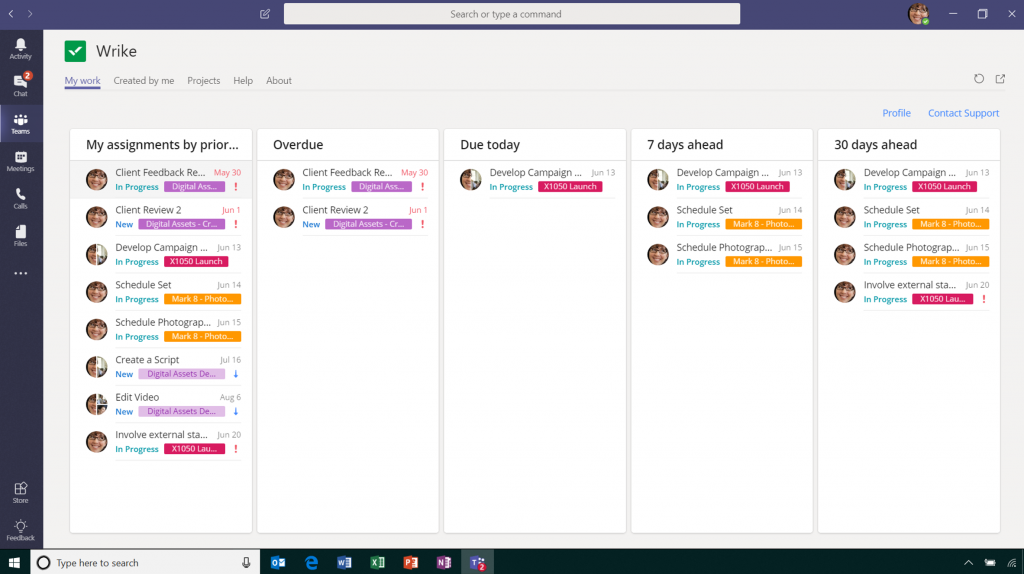
Wrike
The user interface is straightforward to understand, and there are distinct tasks, folders, and spaces present for better navigation. Quick toggling between activity stream, reports, calendar, dashboards, home screen, and timesheets is available. There is also a dedicated Getting Started guide, which offers help regarding the tool’s usage.
There are over 400 different inbuilt native integrations available. The most popular ones among them are Salesforce, Dropbox, Google, and Microsoft. Wrike charges 9.80 dollars per month per user. There are four different price plans available upon consultation, and apparently, a free version is available as well.
4. ProjectManager
ProjectManager is a great choice for scrum software that can use various hybrid methodologies for project management. By definition, it isn’t really specialized in scrum tool project management. It has multiple awards to its name and is used by some giant institutions, such as Ralph Lauren, Volvo, and NASA. The basic plan of this scrum software also allows the working of small teams consisting of 5 users.
The reason why ProjectManager can be used as a great scrum software is because of its useful features. A team using this tool will get multiple advantages. These include getting visualization of the work with dashboards and Kanban boards in real-time.
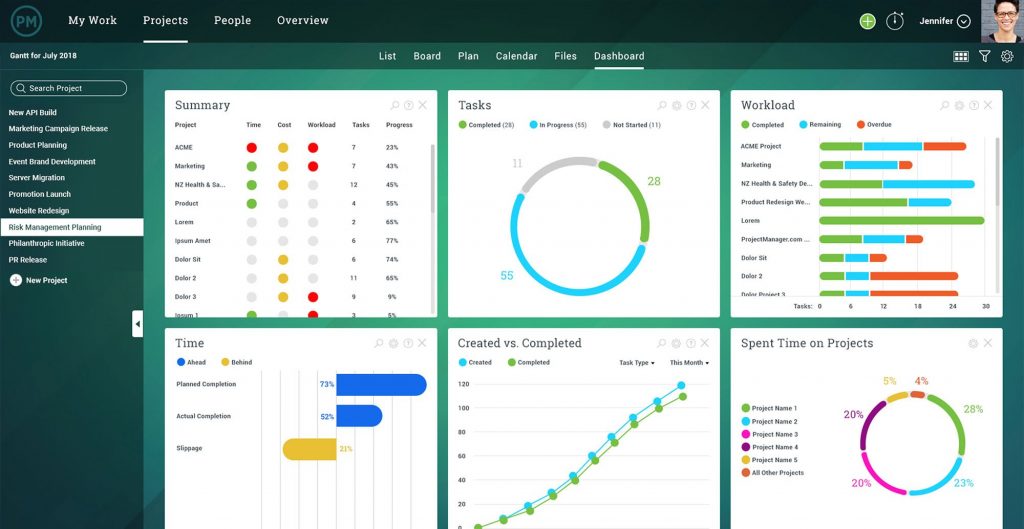
ProjectManager
Different tasks and views can be switched simultaneously and seamlessly. Basic but useful alerts, such as automated notifications, can help finish the due tasks in time. Apps like Drive, Calendar, Gmail, MS Office, and MS Project all have integrations on ProjectManager. Integrations with other apps can also be attained via Zapier.
ProjectManager also offers a free trial of their software for 30 days. As for the starting plan, the Personal plan is charged at 15 dollars per month per user. This plan requires the commitment of at least 5 users, though.
5. Nutcache
Nutcache is yet another tool that specializes in the management of billing, expenses, and time. This platform for collaboration is handy for task analyzing, organizing, and planning. It can handle both complex and basic project management levels. There are also additional features such as payment of invoices for different projects and time tracking.
Users also get color coding to track and manage their schedules and tasks. Data reporting and organization queues are also available. The view of the scrum board and the visual Gantt chart can be switched easily.
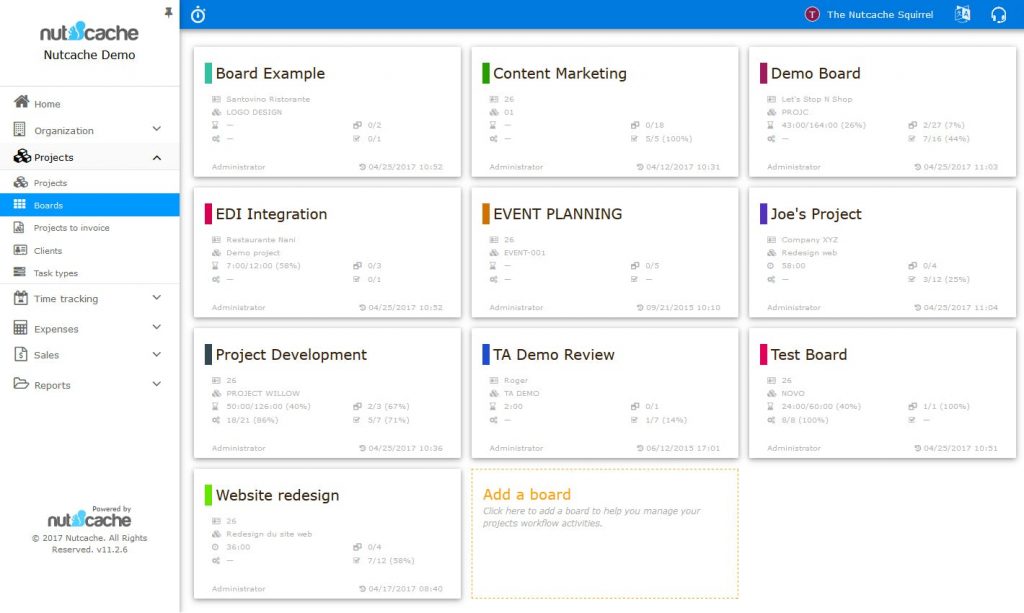
Nutcache
There are multiple features present in Nutcache which are helpful in spring management as well. Some of them include allowing the users to choose the goal and define the sprint duration. The sprint can also be linked to the release, and it can be easily closed when the said duration is over.
The sprint goal also allows users to become aligned with the processes. These include improving the sprit workflow with labels, defining the acceptance tests, and measuring the tasks’ progress.
Nutcache has multiple integrations. The major ones include Google Drive, GitHub, Stripe, PayPal, Dynacom Accounting, and many more. The other apps can also be accessed via Zapier. Nutcache offers a pro plan, and a minimum of 5 users are required for it. In this plan, each user needs to pay 6 dollars per month.
6. Jira
Jira is one of the scrum tools that are highly useful for software testing and engineering. For most of the agile teams, Jira is widely used as it is cloud-based. Various project management applications have included their integration with Jira due to its popularity.
Even though Jira’s customization in visualizations of the dashboard isn’t the best globally, it is still perfect. Custom reports can also be created very easily with this tool. Jira is extremely well rounded and equally beneficial for enterprises, middle-sized teams, and small-sized teams.
Jira offers multiple useful tools for project management. Some of them include Kanban and Scrum boards, which are customizable. Other things include visual reports, such as velocity, cumulative flow, burndown, and so on.
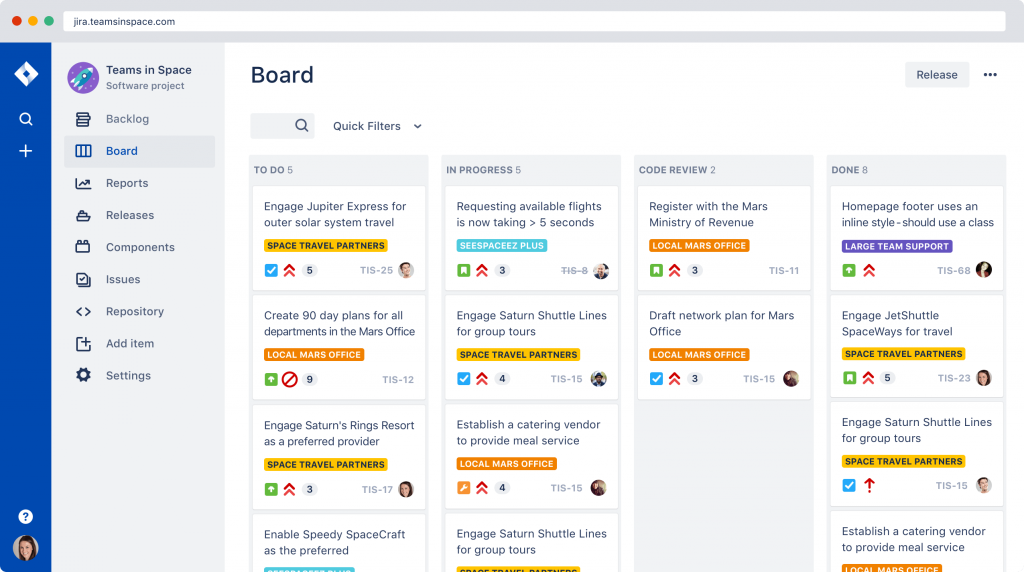
Backlog grooming is possible with adjustable workflows and custom filters. High-level BPM functionalities, such as sandbox tools, process templates, and road mapping, is also available. In this way, the users can get an idea about the outcome before estimating and investing the resources.
Jira is available on every mobile platform and has integration with 3k+ apps. Jira uses various development tools for integration with the software development ecosystem. Bugs can be easily identified, with pull requests and failing builds easily spottable with real-time task overview.
For up to 10 users, Jira charges 10 dollars per month. It also acts as one of the free scrum tools for educational institutions and charitable organizations, with a free license.
7. Targetprocess
For those who use SAFe and LeSS, Targetprocess is the best scrum tool available. The tool has been developed over 15 years, and at present, it can support the agile frameworks of multiple applications. The tool has been designed, keeping in mind the various project management styles and their different use cases.
Companies that are more focused on making their software adaptable instead of using it on different platforms will find Targetprocess to be highly beneficial. The comparatively small-sized projects that are quickly projected to scale will also benefit from using Targetprocess.
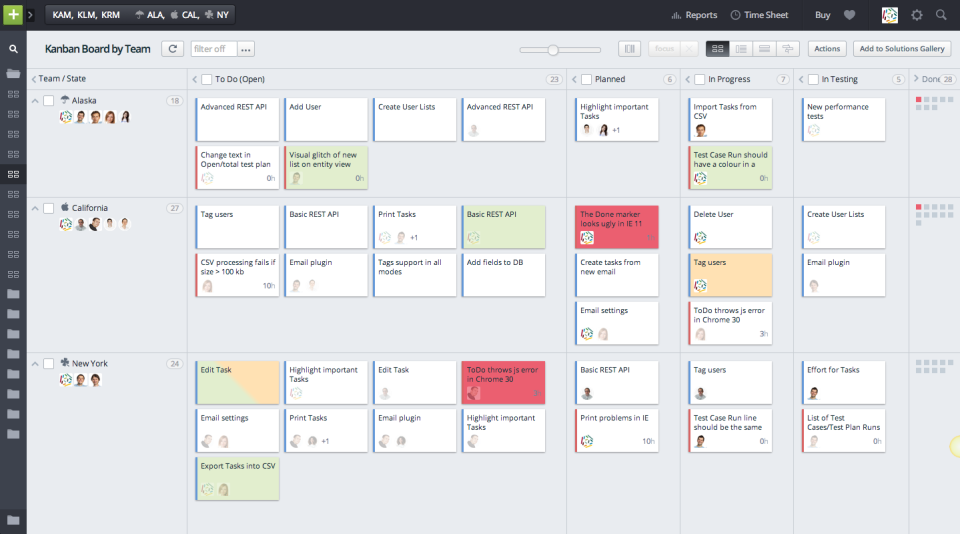
Targetprocess
Targetprocess offers great customizable options, and graphs, views, cards, and reports can all be customized. This is a highly adaptive scrum tool that is usable on different levels. SAFe, or Scaled Agile Framework, gets supported fully by Targetprocess. Thus, users can implement Kanban frameworks in team level, program, value stream, or portfolio.
As for integration, Targetprocess can go through SDK, REST API, webhooks, plugins, and mashups. Thus, this tool is extremely adjustable and can be used for syncing various tools at once. The mobile application is available on both iOS and Android platforms.
The team version for Targetprocess is absolutely free for all users. It charges 20 dollars per month for the Company version.
8. ClickUp
For bargain hunters and lovers of multiple features, ClickUp is a great scrum tool for project management. This tool imposes a perfect balance between practicality and high performance. A large variety of resources are available for training. The tool is also straightforward to learn and equally easy for customization and integration. Modern technologies, such as ML and NLP, are also utilized by ClickUp.
When compared with similar applications, ClickUp presents a much broader field of functions. Mainly, it includes features such as scheduling, time tracking, project templates, and Gantt charts. The functionality is also expanding with time, and it is highly recommended to use both as a scrum tool and business process management tool.
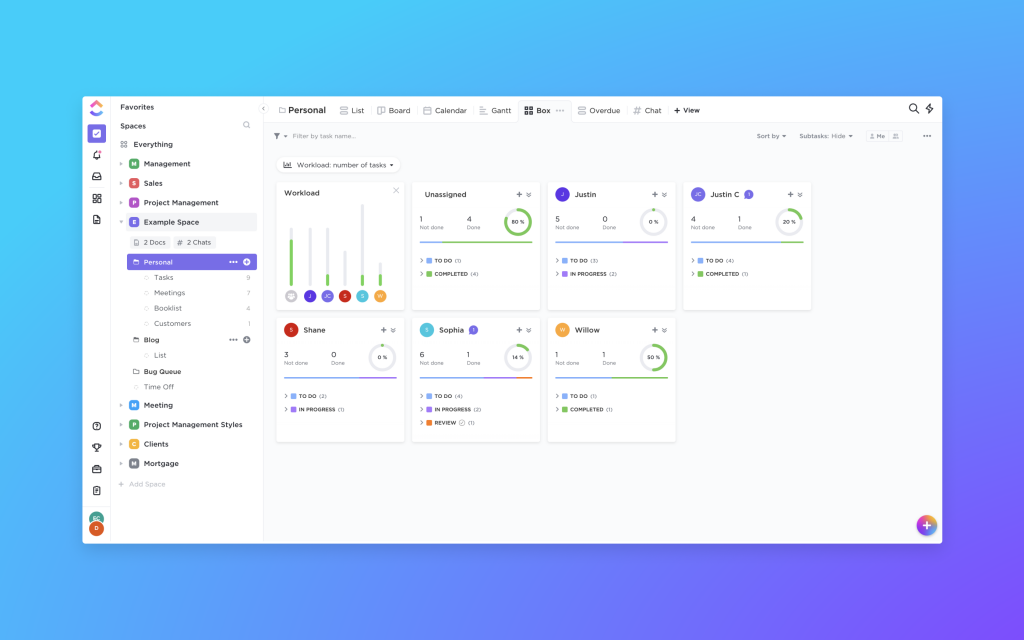
ClickUp
AI is used optimally for its functions. To make the users more comfortable with exact formatting, ClickUp uses NLP or Natural Language Processing. ClickUp is also tipped for rolling out Machine learning soon, and it will help estimate time and predict the task assignees automatically.
There are over 1000 integrations in ClickUp, and CSV files are used for importing the data. Apps such as Asana, Jira, Trello, Flow, and many others are available on multiple platforms.
There is a free version of ClickUp available for all users. As for the pro version, each user needs to pay 5 dollars per month.
9. Vivify Scrum
Vivify Scrum is one of the best scrum tools for project management in terms of the user interface. The tool is very much well balanced, and the UI is beautiful. Apart from that, this app is cloud-based, which means it can be accessed from anywhere in the world.
The projects’ management becomes extremely seamless with Vivify Scrum, and the superfast navigation enhances the process. Files management packages and invoices are also available in this tool. The functionality is not the world’s best, but it can still support large institutions with many users. Moreover, the highly detailed reporting and the configuration is also beneficial for the users.
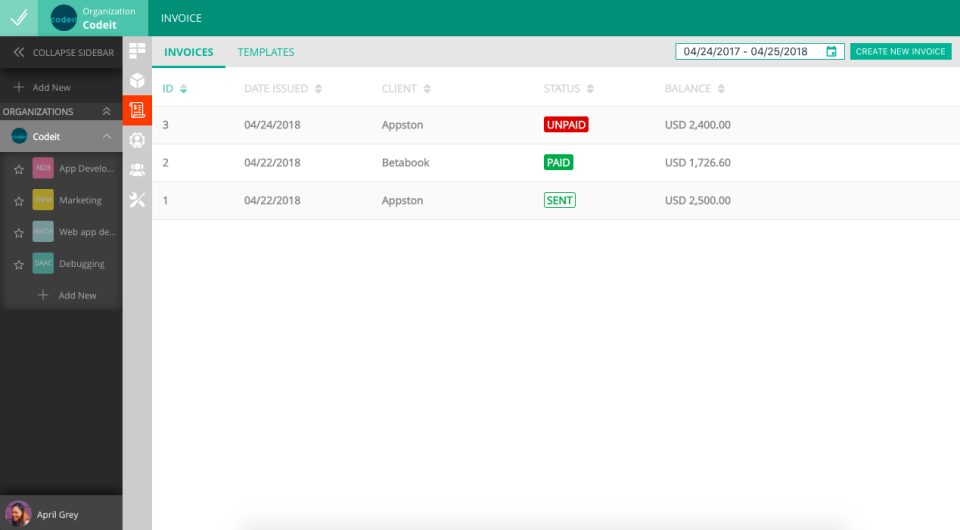
Vivify Scrum
The free version of Vivify Scrum offers both Kanban and Scrum boards, and custom build workflows are available. Also, burndown charts are there for visualizing reports and managing tasks. The tool allows 1 external integration and has other integration with apps like Pivotal Tracker, GitHub, Trello, Jira, Slack, etc. Its mobile version is available on both the Android and iOS platforms.
Vivify Scrum offers a free version for all users. This way, any of the users can get a taste of the practical experience of the app. If they are not satisfied with the free features, they can go for the premium plans. A 14-day free trial is available for interested users to try Vivify Scrum out for the premium version. After the trial period is over, the premium plan is charged at 1 dollar per user per month.
10. Axosoft
The nature of this tool is extremely configurable. As a result, different users can determine the type of support they require, as Axosoft can support all types of complexity. The release planner of this tool enables the users to see the capacity at member, team, and sprint levels.
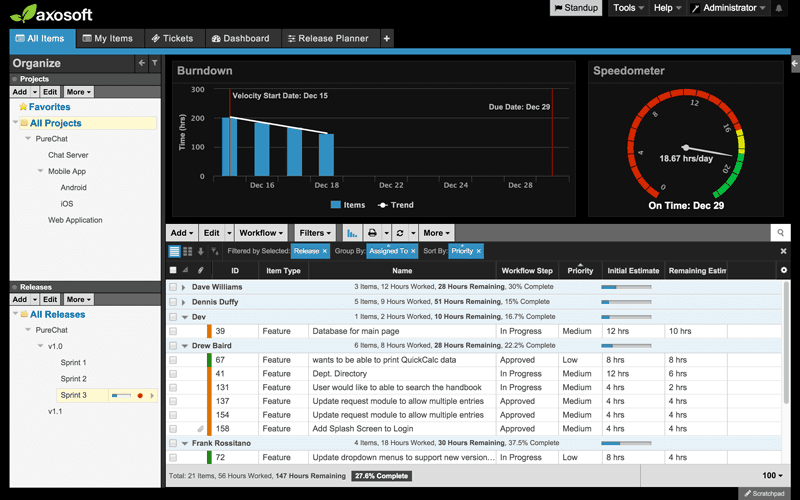
Axosoft
There are over a dozen integrations, with GitHub, Slack, Trello, and other apps available via Zapier. Even though the number of apps that have integration is less, the apps are specified. Each of these dozen apps has perfect features that can eventually help in the process of project management. There is also a mobile app for Axosoft present.
As for the pricing, Axosoft charges 25 dollars per month, up to 5 users. The pricing is quite decent, and a huge number of processes are available for the said charge.
11. Scrumwise
Scrumwise consists of all the basic features, including sprint management, managing backlogs, time, and tasks. The Kanban boards available can be dragged & dropped, with simple burndown chart visualizations. The tool has been designed such that complexities do not arise, and this makes it a good tool for small-sized and middle-sized teams.
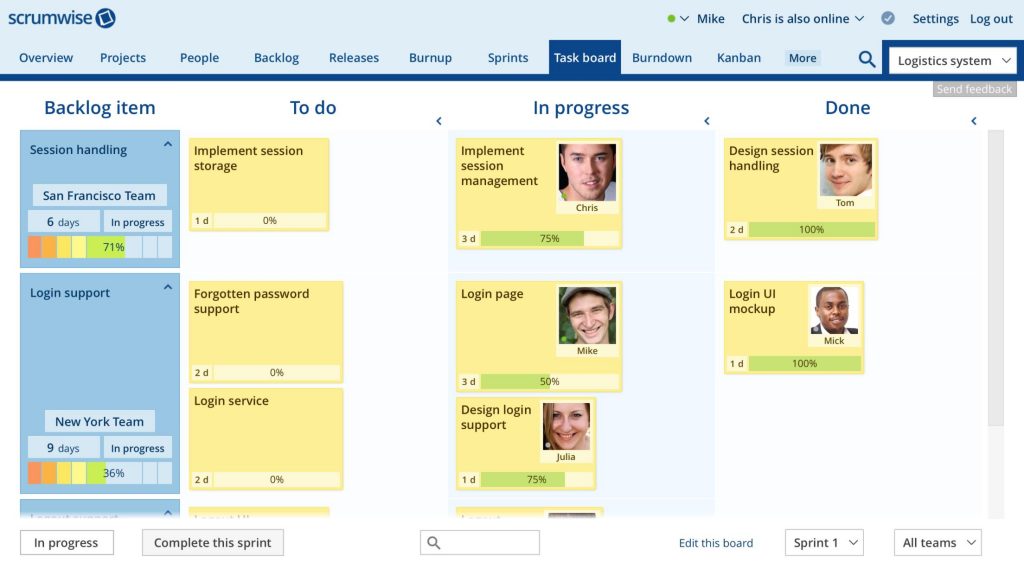
Scrumwise
Data exporting is elementary in this tool. Simple gestures like Copy and Paste are enough to export the files in XML or CSV format. Syncing is done in both 1 way and 2 way by enabling API. It does have the bare minimum integrations among all other scrum applications though. However, it hosts a mobile app that runs on both Android and iOS devices. The app also supports its features on different platforms.
Conclusion
Also, the size of the team should always be considered. Small-sized teams are lucky in many ways, as multiple scrum applications are available for free for small teams. If someone is planning to upgrade, then suitable tools should be used. Also, integration tools should be considered before choosing a software. Different users may have different needs, for which the integrated software can play a significant role.
Moreover, how easily a user can understand all the Scrum tool’s features and utilize it is also important for saving time and effort. Keeping all these factors in mind, and after checking the budget, the right scrum software should be chosen.

No Responses